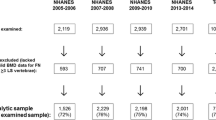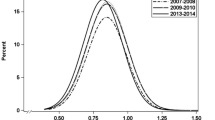Abstract
Summary
This analysis examines lumbar spine bone mineral density (BMD) of US adults from NHANES 2005–2008 by age, sex, and race/ethnicity. Prevalence of low spine BMD and agreement between the prevalence of low BMD at the spine and femur neck in older adults are also assessed.
Introduction
Lumbar spine BMD data from a representative sample of the US population have not been previously available.
Methods
We used data from the National Health and Nutrition Examination Survey 2005–2008 to examine demographic patterns in lumbar spine BMD among US adults age ≥20 years and the prevalence of low lumbar spine BMD in adults age ≥50 years. Agreement between the prevalence of low BMD at the femur neck and spine in older adults was also assessed. Dual-energy X-ray absorptiometry was used to measure lumbar spine and femur neck BMD. World Health Organization definitions were used to categorize skeletal status as normal, osteopenia, or osteoporosis.
Results
Compared to non-Hispanic whites, non-Hispanic blacks had higher and Mexican Americans had lower lumbar spine BMD. Lumbar spine BMD declined with age in women, but not in men. Approximately 4.7 million (10%) older US women and 1 million (3%) older men had lumbar spine osteoporosis in 2005–2008. Roughly one third of them differed in skeletal status at the spine and hip but most were normal at one site and osteopenic at the other. Only 3–10%, depending on sex, had osteoporosis at one skeletal site but not at the other skeletal site. Between 76% and 87% with discordant skeletal status had lumbar spine T-scores within 1 unit of the category threshold.
Conclusions
These findings suggest that measuring either the femur neck or the lumbar spine will correctly classify the majority of individuals who present for care as osteoporotic or not.




Similar content being viewed by others
References
Kanis JA, McCloskey EV, Johansson H, Oden A, Melton LJ, Khaltaev N (2008) A reference standard for the description of osteoporosis. Bone 42:467–475
National Osteoporosis Foundation (2008) Clinician’s guide to prevention and treatment of osteoporosis. National Osteoporosis Foundation, Washington D. C., pp 1–36
Management of osteoporosis in postmenopausal women: 2010 position statement of The North American Menopause Society. Menopause. 2010; 17:25–54
Hodgson SF, Watts NB, Bilezikian JP, Clarke BL, Gray TK, Harris DW, Johnston CC Jr, Kleerekoper M, Lindsay R, Luckey MM, McClung MR, Nankin HR, Petak SM, Recker RR (2003) AACE Osteoporosis Task Force. American Association of Clinical Endocrinologists medical guidelines for clinical practice for the prevention and treatment of postmenopausal osteoporosis: 2001 edition, with selected updates for 2003. Endocr Pract 9:544–564
Baim S, Binkley N, Bilezikian JP, Kendler DL, Hans DB, Lewiecki EM, Silverman S (2008) Official positions of the International Society for Clinical Densitometry and executive summary of the 2007 ISCD position development conference. J Clin Densitom 11:75–91
American College of Obstetricians and Gynecologists Women’s health Care Physicians (2004) Osteoporosis Obstet Gynecol 104(Suppl 104):66S–76S
Leslie WD, Lix LM, Johansson H, Oden A, McCloskey E, Kanis JA (2011) Spine-hip discordance and fracture risk assessment: a physician-friendly FRAX enhancement. Osteoporos Int 22:839–847
Centers for Disease Control and Prevention, National Center for Health Statistics (2011) 1999—Current National Health and Nutrition Examination Survey (NHANES). Available at: http://www.cdc.gov/nchs/about/major/nhanes/currentnhanes.htm. Accessed 5 May 2011
Centers for Disease Control and Prevention, National Center for Health Statistics (2011) National Health and Nutrition Examination Survey body composition procedure manual. Hyattsville, MD; U.S. Department of Health and Human Services, Centers for Disease Control and Prevention, [2006] Available at: http://www.cdc.gov/nchs/data/nhanes/nhanes_05_06/BC.pdf. Accessed 5 May 2011
Centers for Disease Control and Prevention, National Center for Health Statistics. National Health and Nutrition Examination Survey dual-energy X-ray absorptiometry (DXA) procedure manual. Hyattsville, MD: U.S. Department of Health and Human Services, Centers for Disease Control and Prevention, [2007]. Available at: http://www.cdc.gov/nchs/data/nhanes/nhanes_07_08/manual_dexa.pdf. Accessed 5 May 2011
World Health Organization (1994) Assessment of fracture risk and its application to screening for postmenopausal osteoporosis. Technical Report Series No. 843. WHO, Geneva Switzerland
Kelly TJ (1990) Bone mineral density reference databases for American men and women. J Bone Miner Res 5(Suppl1):S249
Looker AC, Wahner HW, Dunn WL, Calvo MS, Harris TB, Heyse SP, Johnston CC Jr, Lindsay R (1998) Updated data on proximal femur bone mineral levels of US adults. Osteoporos Int 8:468–489
Centers for Disease Control and Prevention, National Center for Health Statistics. National Health and Nutrition Examination Survey NHANES response rates and CPS totals. Hyattsville, MD: U.S. Department of Health and Human Services, Centers for Disease Control and Prevention, [2010]. Available at: http://www.cdc.gov/nchs/nhanes/response_rates_CPS.htm. Accessed 5 May 2011
Melton LJ 3rd (1995) How many women have osteoporosis now? J Bone Miner Res 10:175–177
Woodson G (2000) Dual X-ray absorptiometry T-score concordance and discordance between the hip and spine measurement sites. J Clin Densitom 3:319–324
Mounach A, Abayi DA, Ghazi M, Ghozlani I, Nouijai A, Achemlal L, Bezza A, El Maghraoui A (2009) Discordance between hip and spine bone mineral density measurement using DXA: prevalence and risk factors. Semin Arthritis Rheum 38:467–471
El Maghraoui A, Mouinga Abayi DA, Ghozlani I, Mounach A, Nouijai A, Ghazi M, Achemlal L, Bezza A (2007) Prevalence and risk factors of discordance in diagnosis of osteoporosis using spine and hip bone densitometry. Ann Rheum Dis 66:271–272
Moayyeri A, Soltani A, Tabari NK, Sadatsafavi M, Hossein-Neghad A, Larijani B (2005) Discordance in diagnosis of osteoporosis using spine and hip bone densitometry. BMC Endocr Disord 5:3
Fink HA, Harrison SL, Taylor BC, Cummings SR, Schousboe JT, Kuskowski MA, Stone KL, Ensrud KE (2008) Study of Osteoporotic Fractures (SOF) Group. Differences in site-specific fracture risk among older women with discordant results for osteoporosis at hip and spine: study of osteoporotic fractures. J Clin Densitom 11:250–259
Stoch SA, Wysong E, Connolly C, Parker RA, Greenspan SL (2000) Classification of osteoporosis and osteopenia in men is dependent on site-specific analysis. J Clin Densitom 3:311–317
Leslie WD, Tsang JF, Caetano PA, Lix LM (2007) For the Manitoba bone density program. Number of osteoporotic sites and fracture risk assessment: a cohort study from the Manitoba bone density program. J Bone Miner Res 22:476–483
O’Gradaigh D, Debiram I, Love S, Richards HK, Compston JE (2003) A prospective study of discordance in diagnosis of osteoporosis using spine and proximal femur bone densitometry. Osteoporos Int 14:13–18
Leslie WD, Lix LM, Tsang JF, Caetano PA (2007) Manitoba bone density program. Single-site vs multisite bone density measurement for fracture prediction. Arch Intern Med 167:1641–1647
Kanis JA, Johnell O, Oden A, Johansson H, Eisman JA, Fujiwara S, Kroger H, Honkanen R, Melton LJ 3rd, O’Neill T, Reeve J, Silman A (2006) Tenenhouse A. The use of multiple sites for the diagnosis of osteoporosis. Osteoporos Int 17:527–534
Blake GM, Patel R, Knapp KM, Fogelman I (2003) Does the combination of two BMD measurements improve fracture discrimination? J Bone Miner Res 18:1955–1963
Looker AC, Melton LJ 3rd, Borrud Harris TB, Borrud LG, Shepherd JA (2010) Prevalence and trends in low femur bone density among older US adults: NHANES 2005–2006 compared with NHANES III. J Bone Miner Res 25:64–71
George A, Tracy JK, Meyer WA, Flores RH, Wilson PD, Hochberg MC (2003) Racial differences in bone mineral density in older men. J Bone Miner Res 18:2238–2244
Araujo AB, Travison TG, Harris SS, Holick MF, Turner AK, McKinlay JB (2007) Race/ethnic differences in bone mineral density in men. Osteoporos Int 18:943–953
Taaffe DR, Villa ML, Holloway L, Marcus R (2000) Bone mineral density in older non-Hispanic Caucasian and Mexican American women: relationship to lean and fat mass. Annals Human Biol 27:331–344
Nam HS, Shin MH, Zmuda JM, Leung PC, Barrett-Connor E, Orwoll ES, Cauley JA (2010) Osteoporotic Fractures in Men (MrOS) Research Group. Race/ethnic differences in bone mineral densities in older men. Osteoporos Int 21:2115–2123
Morton DJ, Barrett-Connor E, Kritz-Silverstein D, Wingard DL, Schneider DL (2003) Bone mineral density in postmenopausal Caucasian, Filipina, and Hispanic women. Int J Epidemiol 32:150–156
Orwoll ES, Oviatt SK, Mann T (1990) The impact of osteophytic and vascular calcifications on vertebral mineral density measurements in men. J Clin Endocrinol Metab 70:1202–1207
Yu W, Glüer CC, Fuerst T, Grampp S, Li J, Lu Y, Genant HK (1995) Influence of degenerative joint disease on spinal bone mineral measurements in postmenopausal women. Calcif Tissue Int 57:169–174
Rand T, Seidl G, Kainberger F, Resch A, Hittmair K, Schneider B, Glüer CC, Imhof H (1997) Impact of spinal degenerative changes on the evaluation of bone mineral density with dual energy X-ray absorptiometry (DXA). Calcif Tissue Int 60:430–433
Liu G, Peacock M, Eilam O, Dorulla G, Braunstein E, Johnston CC (1997) Effect of osteoarthritis in the lumbar spine and hip on bone mineral density and diagnosis of osteoporosis in elderly men and women. Osteoporos Int 7:564–569
Jones G, Nguyen T, Sambrook PN, Kelly PJ, Eisman JA (1995) A longitudinal study of the effect of spinal degenerative disease on bone density in the elderly. J Rheumatol 22:932–936
Riggs BL, Melton LJ, Robb RA, Camp JJ, Atkinson EJ, McDaniel L, Amin S, Rouleau PA, Khosla S (2008) A population-based assessment of rates of bone loss at multiple skeletal sites: evidence for substantial trabecular bone loss in young adult women and men. J Bone Miner Res 23:205–214
Melton LJ, Khosla S, Atkinson EJ, O’Connor MK, O’Fallon WM, Riggs BL (2000) Cross-sectional versus longitudinal evaluation of bone loss in men and women. Osteoporos Int 11:592–599
Henry MJ, Pasco JA, Seeman E, Nicholson GC, Sanders KM, Kotowicz MA (2001) Assessment of fracture risk: value of random population-based samples—the Geelong Osteoporosis Study. J Clin Densitom 4:283–289
Faulkner KG, Roberts LA, McClung MR (1996) Discrepancies in normative data between Lunar and Hologic DXA systems. Osteoporos Int 6:432–436
Zimmerman SI, Girman CJ, Buie VC, Chander J, Hawkes W, Martin A, Holder L, Hebel JR, Sloane PD, Magaziner J (1999) The prevalence of osteoporosis in nursing home residents. Osteoporos Int 9:151–157
Conflicts of interest
None.
Author information
Authors and Affiliations
Corresponding author
Additional information
The findings and conclusions in this report are those of the authors and do not necessarily represent the views of the Centers for Disease Control and Prevention or the Department of Health and Human Services.
Appendix
Appendix
Rights and permissions
About this article
Cite this article
Looker, A.C., Melton, L.J., Borrud, L.G. et al. Lumbar spine bone mineral density in US adults: demographic patterns and relationship with femur neck skeletal status. Osteoporos Int 23, 1351–1360 (2012). https://doi.org/10.1007/s00198-011-1693-z
Received:
Accepted:
Published:
Issue Date:
DOI: https://doi.org/10.1007/s00198-011-1693-z




